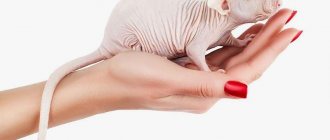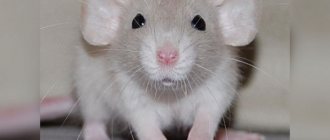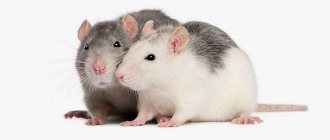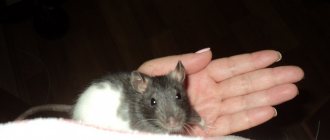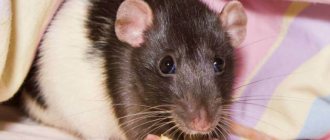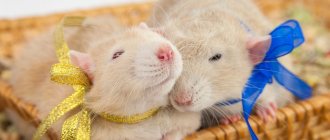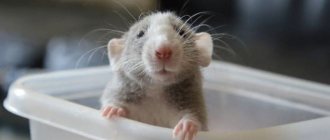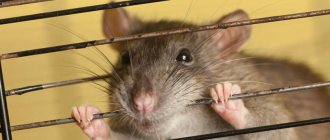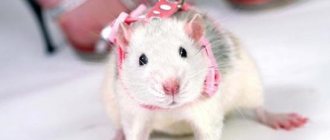The Rex Rat breed owes its birth to a mutation that was accidentally obtained by breeders. The offspring of this hybrid had curly hair. When breeders noticed the unusual fur of rats, they decided to fix the mutated gene and thus created a new species of rat for the world to see.
The Rex breed does not have official status - it is not listed in the standards and is considered a subspecies.
Description of appearance
These animals are unique mainly because of their curly coat. Otherwise they look like other breeds.
It is not difficult to recognize Rex by his appearance. Healthy purebred animal:
- The coat is thick and curly, without bald spots or rosettes;
- The curls on the coat are springy;
- the muzzle is wide and blunt;
- The ears are large and widely spaced;
- fluffy tail.
Subspecies
The breed includes three subspecies. The main one is the breed standard described above. The other two are intrabreed subspecies:
- Dumbo Rex (the variety is named after the famous baby elephant from the Disney cartoon, so the peculiarity of the Dumbo Rex rat is immediately clear from its name - these are large round ears, the fur of the animal does not differ from the breed standard);
- Double Rex (a semi-hairless variety - the rat looks as if it had been shorn, the fur of the animal is very short, sticking out in different directions due to curliness, otherwise the appearance of the animal does not differ from the breed standard).
Appearance of a rex rat
Rex rats were bred on the basis of the Standard breed, their main parameters coincide with this designation, with the exception of the composition and quality of the fur.
The body length of the imago sometimes reaches 27 cm.
Important: The main difference between a Rex and a standard rat is that there is less hair in the coat structure.
Curly rats have a dense coat with evenly distributed curls. They have almost no fluff on their bellies. The fur has a low hair content, so their coat is not as shiny as a standard rat's.
The vibrissae are strongly curled, but have a shorter length compared to the vibrissae of other ornamental rodents. The curly fur of a rat is a little thicker, but not very coarse.
Wavy rexes have fewer curls than curly rexes, but their fur is dense and soft, and appears slightly ruffled from the side. Their dense undercoat has a uniform hairline. They can be slightly longer than curly rats and have a wavy shape. Sometimes there are people with vibrissae that curl at the ends.
These animals are especially charming due to their thin tentacles, which are located just above the eyes.
A purebred rex rat has the following characteristics:
- Thick and curly coat with bouncy curls;
- wide, slightly blunt muzzle;
- large, widely spaced ears;
- The bushy tail is also a characteristic of the breed.
Rat fur has a plush softness. Children are born curly if both parents have the curly hair gene. Rex puppies always have a somewhat disheveled appearance - over time, their undercoat begins to fall out and hairless spots form, but these are quickly replaced by new hair.
Interesting! There are mongrels of this breed. Red and black or red and ruby color combinations are not considered a defect. They can occur in animals with any marking.
Features of maintenance and care
If you are planning to buy a Rex rat, you will need to get equipment for breeding this animal:
- Spacious cage.
- Food bowls.
- Separate shelter house. It is better if it is made of hardwood.
- Swing.
- Hanging toys, hammock.
Your pet's cage should be cleaned weekly. Disinfect the cage once a month. It is very important for your pet to have a clean home and always have fresh water in it. You can pour it into a bowl or buy a boozer from a pet store.
It is better to feed the animal in the evening, but part of the daily ration can be given in the morning. The most common question about caring for frizzy rats (fly rats) is the specifics of their diet. Experts recommend taking ready-made formulas as the basis of a rex's diet. It is necessary to add vitamins, grains, fruits, and herbs to them. A rat eats 15-20 g of food per day.
If the rodent's diet consists mainly of natural food, it should include:
- semi-finished products;
- fresh apples;
- leaf salad;
- pieces of boiled chicken meat;
- boiled eggs;
- seeds;
- sour cream;
- kefir;
- fruits and dried fruits.
Important: You can treat your pet with unsweetened breadcrumbs from time to time, especially during training.
Nutrition
The rat diet should be based on ready-made food. Mandatory feed additives include cereals and vitamins. You can feed your pet with the following:
- half-boiled porridge;
- fruits (especially apples and plums);
- greens;
- boiled lean chicken;
- boiled eggs;
- fruits;
- seeds;
- sour cream;
- kefir
Unsweetened crackers can be given as a treat.
Character and nicknames
These rats are less active than their other relatives. They quickly get used to their owners and become tamed. This rodent can quickly get used to its name and return to its cage at the first call.
When choosing a name for your rat, try to make it sound and simple, because rodents do not tend to remember long words. Ideally, the name should contain consonants so that the animal can more easily perceive it by ear. For example, the female can be called Goldie, Bonya, Dina, Lala, Sonya or Ollie, and the male can be called Ballou, Winnie, Teddy, Pete, Shonya, Duck or Tosha.
After some time, the dam will learn to respond to the sound of your voice and will run towards you. If you plan to let him outside to run around, you will need to hand train him first before returning him to his crate. When training a rodent, remember that he is not a dog, so be patient.
Description of the breed
The Dumbo rat differs from the typical ornamental pattern of the rat breed by having low, rounded ears; the larger the ears, the more valuable the specimen of the breed. The breed was named after the adorable little elephant, beloved by children all over the world, of the same name.
Dumbo is a Disney cartoon character known for his huge round ears. Ratatouille is another smart and cute cartoon character from this movie studio and a representative of the Dumbo ratbo decoration.
Dumbo (Mickey Mouse)
They differ in the structure of the skull and the shape of the ears, which are located not on top of the head, but below. As a result, the animal's head appears slightly flattened and expanded. The ears are round and elongated.
These rats come in two varieties - completely open and with slightly curved edges. There may be specimens with a slightly protruding neck, although this is usually barely noticeable. The animal's body shape is slightly wider at the back, but the size is smaller than other breeds.
Longhair
Long-haired varieties of rats differ from standard ones in that they have longer hair.
Sphynx (hairless) rats
There may be drooping on the head, paws and groin area. Typically, rodents have pink skin in folds, but there are individuals with dark spots. The vibrissae of this species are shorter than those of the standard species and can curl.
Decorative sphinx rats should be protected from both cold and overheating.
Downy (fuzz)
Furry rats are similar in appearance to sphinxes, but the “hairy” rat gene is at work. The skin of pheasants is covered with down - there are no downy hairs. The hair is longer on the face and lower body. The mustache is short and curved.
Unlike sphinxes, furry animals are valued more “dressed.” Fuzzy is more hardy than sphinxes and is easier to hatch. However, a thin bladder does not always protect against overheating or cooling, so animals require special attention.
Dazzling rats have beautiful fur - not full-fledged “clothing”.
Rex (curly)
The coat is similar to that of a cat of the same breed - it is hard and curly. Elastic curls do not appear immediately. Rats have not yet developed curls, and the hair can stick out in different directions.
This is the reason why babies look dirty. According to the breed standard, the coat should be uniform, without bald spots. These animals have short curly whiskers. In other cases, Rexes are similar to the standards.
Rex babies sometimes look disheveled.
Double Rex
Such rats are born when mom and dad are carriers of the “curly” gene. The fur of such animals is unusual. The fur has fluffy patches and coarse, spindly hairs.
Another feature is shedding. Since childhood, rats lose their fur, and the fur coat resembles a patchwork quilt. The hair areas alternate with partridges. Later, hair grows in bald areas and falls out in the “hairy” areas. Double rexes are not officially recognized as a species.
Double rex rats have fur covered in patches.
Satin (satin)
Satin or satin rats are distinguished by a thin, shiny coat. Glossy fur gives animals an attractive appearance. A thin layer makes the hair visually longer. Satins can have a short coat like the standards. Long hair does not define this variety: not every long-haired rat is a satin.
The satin or satin rat is covered in fine, glossy fur.
Manx
This species of rat does not have a tail, so it is not particularly valued as it is considered handicapped. The fact is that most of these rats have problems with their hind legs and urinary system. These animals can be of different colors. Their fur can be wavy and curly.
Standard
Animals of this type have a standard design. They are slender and agile. The animal's tail is almost the same length as the entire body and head. The eyes are large and shiny, round in shape, their color is in harmony with the color of the fur coat according to the standard.
Small, well-shaped ears are located at the top of the head. The rodent has hair all over its body, it is shiny and well attached. There is short hair on the legs and tail.
Light-colored animals have a short, velvety coat on their ears. They have long and proportional whiskers located on their cheeks. They also have whiskers above their eyes, but they are much smaller and shorter there.
Rodents with other types of fur have short, sparse and curled whiskers. Standard rats are considered the largest among decorative rodents and can weigh up to 500 grams.
By coat color
Decorative rats are also conventionally divided into several groups according to the type and color of their coat.
Homogeneous
Rodents of this species have absolutely the same coloring throughout their entire body. Rats are black, white, blue (color with a silver tint. Russian blue and smoky blue are also found. They are very similar in color, the former have a dark color and a light belly, and the latter have a more pronounced blue tint.
Rats in gray-brown tones with a silver-bluish tint with cherry eyes are called mink. There is also an American mink species, these animals have a darker eye shade.
Light gray color with a cool blue tint. The eyes are black or dark red. This is a platinum shade. Blue, platinum rat
Article on the topic: Husky rat - description of the species with photographs
The beige color of the rats resembles coffee with milk. And completely white animals with red eyes are usually called albinos.
Very beautiful coloring of rats - champagne. This species of animal has a light, slightly pinkish color. The eyes are pink.
Russian silver is an interesting light gray color with a blue tint. This variety is characterized by fuzzy ripples of color.
The main color of the “dav” species is pale gray with a pinkish tint. It has a characteristic light ripple. Rat "Lilak" - light ash color, slightly mixed with chestnut color. Eyes black or dark cherry.
Officially unrecognized colors of domestic rats:
Ticked colors
They are distinguished by uneven coloring of the hairs, that is, there are places on them that may have pigments of different colors.
Agouti
This coloring is characterized by a beautiful chestnut color. Some hairs are black. Short and medium hairs have bands. They must be free of orange and yellow, and it is better if they are of the lightest shades. The base color consists of a dark gray or light brown tint. The ends of the hairs are black and the belly is silver-gray. Rat - Agouti There is also a blue agouti - the belt of hairs can be red and brown, and the belly is light gray-blue with inclusions of silver hairs.
Incredibly beautiful shade of platinum agouti. This bright color is combined using two colors: light gray and beige with a cool blue tint. Each hair has a light blue base with a beige edge. The belly is light silver.
Amber
Rich color of yellow and orange shades. Each hair has an ivory border. The guard hairs have a silvery tint. The undercoat is cream and the belly is light. The eyes are pink. Amber color
Cinnamon
Rodents are colored in red-brown tones with inclusions of darker guard hairs, which have bright golden and red edgings. The belly is gray with silver, and the eyes are black or cherry. Cinnamon
Article on the topic: Dumbo rat: photos, distinctive features, care and maintenance at home
These rodents have a beautiful coffee color with a golden tint with the inclusion of silvery guard hairs. There is a not very expressive golden-red pattern. The belly is cream and silver, and the eyes are the color of dark ruby. Breed – Fawn
Topaz
This color is similar to the Fawn color, however, it is not as rich and has a lighter undercoat.
Pearl
This species has a light, silvery tint. Eyes black or dark ruby. There are also 2 subspecies: Pearl cinnamon and Pearl blue. The first color consists of three colors: beige, golden and light gray. Overall, it is golden with a silvery tint. Eyes black or dark ruby. The second color is light with beige and gray shades. Each hair is silver-gray in color. The belly is grayish-beige, and the eyes are black or dark cherry. Pearl rat
Silver colors
The uniqueness of this color lies in the variation of silver and colored hairs in the same number. It should be obvious and designed to create the impression of brilliance and sparkle. If there are inclusions of white hairs, then the color is no longer recognized as silver.
- Silver-black. The color of such rodents is deep black with uniform inclusions of silver hairs. The eyes are black.
- Silver blue. The color is gray with a blue tint. Individual hairs are silvery-white. The undercoat is light gray with a blue tint.
- Silver mink. Deep brown color with a gray tint. Has the same amount of silver and brown hairs. Silver rats
Combined colors
This category includes the colors of rats, consisting of a combination of several colors.
Siamese
The animal has a beige color that darkens in the back of the body, moving from the lower back to the tail, and also from the belly to the upper back. The tail is dark at the base along its entire length. The rodent has brown spots on its ears, legs up to the elbows and on its face. Siamese rat Additionally there are:
- Siamese with black eyes. The color is standard for this species, the eyes are dark.
- Siamese blue. It has a cream color with a silver tint that darkens on the back of the body.
- Siamese Russian Blue. The color is beige, gradually darkening in the back of the body. There are dark brownish spots.
Article on the topic: Names for rats, girls and boys: how to name a rodent (help in choosing a nickname)
Himalayan
Snow-white color, which is uniform throughout the body. There are dark brown spots. The eyes are red. The paws are slightly colored. The Black-eyed Himalayan is a white rodent with cream spots. Siamese and Himalayan rats
Burmese
Has an even brown color. Wheaten Burmese - the animal has a sandy coloration with spots of slightly darker tones. The hairs have a yellowish band and a light silver-gray belly. Breed - Burmiz
Sable
Coffee coloring with dark spots on the paws. Breed: Sable Burmese
Important Features
The breed was bred in California laboratories in 1991, and in the 2000s such creatures were brought to Russia from England.
If you are wondering how long do dumbo rats live, then know that these rodents have a lifespan of three years.
The breed grows up to 20 centimeters. Females weigh from 200 to 400 grams, and males from 250 to 500 grams.
Character and life expectancy
The character of Dumbo rats is very friendly; affectionate and trusting animals quickly get used to their owners, remember their nicknames and are easy to train.
Dumbo rats become very attached to their owners.
Young rodents of this breed are more active than their cousins, they enjoy fun and active play with people and other rodents, older animals like to lie on their owner's lap or sit on their shoulder. This breed is very clean, neat and well accustomed to the litter box.
The average life expectancy of rodents of this breed is 2-3 years.
The lifespan of Dumbo rats in a home directly depends on the quality of housing and food. With proper care, timely treatment of rat diseases and feeding a balanced diet consisting of protein and fat with the addition of greens, vegetables, fruits and vitamins, the life of pets is extended to 4-5 years.
Breeding history and appearance
Dumbo rats look very funny and touching because of their large and disproportionate ears with a small head, which makes many people emotional. This breed is especially loved by young children for its attractive appearance.
Dumbo with pointy ears
Dumb rats have two types of cute ears: flat, round, saucer-like ears, or slightly pointed, reminiscent of a half-open tulip bud with a curved petal, the pointiness is slightly pronounced.
When the latter ear variant is pressed from behind, the pinna opens and the regular rounded outline of the ear is visible, Dambo rats with this ear variant are widespread in European countries.
Dumbo with round ears
American scientists bred decorative dumbo rats in the laboratory in 1991 in California, but only 10 years later the charming rodents found their way to Russia.
Despite the popularity of pets with large ears, it is difficult to find rats with clear breed characteristics. The big ears gene is recessive, so it doesn't appear in every litter of rats, even if the parents have particularly large, round ears.
Animals with ears without identifying species are still considered ornamental dumbo rats and can produce adorable babies with adorable round ears.
The body length of animals of this breed does not deviate from standard parameters: males grow to 18-20 cm and weigh 250-500 g, females reach 15-18 cm and weigh 250-400 g.
These rodents have a more pear-shaped short body compared to ordinary decorative rats, and the lower part is more developed than that of the standard breed. The Dumbo breed can have a standard body type, like regular domestic rodents.
The dam's skull is flatter and wider than that of other ornamental rat species, with a relatively pointed snout. The forehead is slightly prominent, but not hunchbacked, and the eyes are large, round and located on both sides of the head. The Dumbo breed has a longer tail than the standard domestic rat.
Colors
Dumbo rat, amber in color. The color of this breed, as well as the length and quality of the coat, can vary greatly within the species. Individuals with short, velvety straight hair are most often found in grey, white, black and chocolate colors. Rare Dumbo rat colors are considered Siamese, Amber, Topaz and Mosaic (Tricolor).
Dumbo rat, tricolor
Incredibly beautiful blue mink rat-dumbo. Can be found only from large breeders, at a fairly high price for decorative rats.
Blue Mink Dumbo Rat
By crossing dam rodents with decorative rats of other breeds, scientists managed to obtain a new subspecies that deserves the attention of amateur breeders.
Dumbo rat, topaz color
If you have problems
The Rex breed is an excellent choice for those who dream of having a beautiful and funny animal. Such pets charm with their playful disposition and become attached to their owner. You'll never get bored with them! But what if the rodent suddenly gets sick, becomes sad or loses its appetite?
In this case, the best solution would be to go to the veterinary clinic. Experienced specialists are well versed in the characteristics of all breeds and will give you many valuable recommendations.
Features of home maintenance
The rat needs a big house where it can run freely without limiting its play time. Due to the high sociability of this species, it is recommended to have several individuals at the same time.
If only one curled up rat can be kept, its cage should contain:
- Swing;
- house;
- climb;
- various entertainments.
Animals are omnivores, but for good health it is necessary to supplement the diet: ready-made industrial feed, vitamins and cereals.
The Rhesus rat's cage should be equipped with entertainment devices.
These animals are easy to care for: just change the food regularly and clean the cage daily. Twice a month their “apartment” must be disinfected. Experts recommend feeding in uneven portions, leaving a large portion for the evening.
Clean water should be available at all times, and then the playful pet will entertain the owner with fun games every day.
